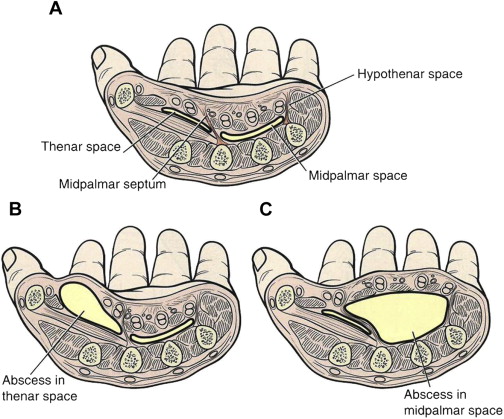The introduction of 3-T MR imaging scanners as well as dedicated wrist coils has allowed for scanning of the unique anatomic structures within the hand with unprecedented accuracy. In this article, the authors discuss common hand conditions, focusing on imaging findings and the utility of MR imaging as it pertains to hand surgery. The authors examine its role in the treatment of hand deep-space infections, scaphoid fractures, scapholunate ligament injuries, thumb ulnar collateral ligament injuries, and ulnar-sided wrist pain.
Key points
- •
Deep-space infections may occur in the potential spaces of the hand. Allied to clinical examination, MR imaging can visualize fluid collections and the spread of tissue inflammation.
- •
MR imaging can diagnose occult scaphoid fractures, whereas other imaging studies often present false negative in the acute stage. It can also aid in the detection of scaphoid proximal pole viability after a fracture.
- •
MR imaging is useful in diagnosing scapholunate ligament tears when features are not yet apparent on radiographs; MR imaging can assess cartilage damage and, thus, direct treatment.
- •
MR imaging of the thumb can help detect an ulnar collateral ligament injury and also the presence of a concomitant Stener lesion.
- •
MR imaging can help with the diagnosis of complete, transverse ulnotriquetral ligament tears and foveal disruption of the triangular fibrocartilage complex with high sensitivity and specificity; however, longitudinal tears may present with more subtle imaging features and subsequently sensitivity ranges between 30% and 58%, with 60% specificity.
Introduction
Common hand injuries like scaphoid fractures, scapholunate (SL) ligament injuries, and triangular fibrocartilage complex (TFCC) tears are typically caused by a fall onto the outstretched hand. In the acute setting, patients may present with vague signs and symptoms, and specific tests during physical examination have a limited specificity to distinguish the myriad of pathologic conditions. Although the radiological workup starts with plain radiographs, these can lack the sensitivity to detect certain soft tissue injuries, such as a SL ligament or TFCC damage. The advent of improved MR imaging technology and dedicated wrist coils has allowed for unique opportunities to visualize subtle soft tissue damage as well as concomitant injuries.
This article discusses common hand conditions, including deep-space infections, scaphoid fracture, SL ligament tears, ulnar collateral ligament (UCL) injuries of the thumb metacarpophalangeal (MCP) joint, and ulnotriquetral ligament (UTL) tears, and focuses on the imaging findings and the utility of MR imaging in their diagnosis and management.
Introduction
Common hand injuries like scaphoid fractures, scapholunate (SL) ligament injuries, and triangular fibrocartilage complex (TFCC) tears are typically caused by a fall onto the outstretched hand. In the acute setting, patients may present with vague signs and symptoms, and specific tests during physical examination have a limited specificity to distinguish the myriad of pathologic conditions. Although the radiological workup starts with plain radiographs, these can lack the sensitivity to detect certain soft tissue injuries, such as a SL ligament or TFCC damage. The advent of improved MR imaging technology and dedicated wrist coils has allowed for unique opportunities to visualize subtle soft tissue damage as well as concomitant injuries.
This article discusses common hand conditions, including deep-space infections, scaphoid fracture, SL ligament tears, ulnar collateral ligament (UCL) injuries of the thumb metacarpophalangeal (MCP) joint, and ulnotriquetral ligament (UTL) tears, and focuses on the imaging findings and the utility of MR imaging in their diagnosis and management.
Deep-space infection of the hand
Anatomy
The deep spaces in the hand and forearm include the thenar, midpalmar, hypothenar, and Parona space ( Fig. 1 ).

Infections in closed cavities or tunnels result in the accumulation of exudates or pus and the establishment of high pressures within the compartments. This state can lead to a reduction of blood flow, regional anoxia, hypoperfusion, and a deficient immune response. The increase in compartmental pressure leads to the expansion of the ischemic zone and facilitates the dissemination of the infection. Thenar space infections are the most common deep-space infections and, if not promptly treated, can spread to the dorsal side of the hand after invading the fascia of the adductor pollicis muscles. A Parona space infection may be isolated or may result from contiguous spread from ruptured radial or ulnar bursae. Such a rupture can involve the midpalmar space and form a horseshoe abscess. Infections to the thenar and midpalmar space may be caused by adjacent infections, such as a superficial abscess or a flexor tenosynovitis.
Imaging
Deep-space infections are diagnosed by physical examination, with the examiner attempting to elicit induration, fluctuance, and the clinical signs of suppurative flexor tenosynovitis: fusiform swelling, pain with passive extension, pain with palpation along the tendon sheath, and a finger held in slight flexion. The distinction between cellulitis, abscess, and flexor tenosynovitis can still be difficult by physical examination alone, but radiographs, ultrasound, and MR imaging can provide critical additional information. Radiographs should be taken in all cases presenting with hand infections to rule out foreign bodies, gas, and chronic osteomyelitis.
Differential Diagnosis
Suspected deep-space infections need to be discerned from flexor tenosynovitis, superficial abscess, and osteomyelitis ( Fig. 2 ). Abscess cavities are most often spherical or elliptical and may contain debris, septae, or gas with the liquefied contents demonstrating a range of echogenicity. Abscess formation can complicate cellulitis and is seen with MR imaging as an intermediate- to low-signal-intensity focal lesion on T1-weighted images, with uniform to slightly heterogeneous high signal intensity on fluid-sensitive images and a peripheral rim of enhancement on postcontrast images. Given the intimate relationship of the midpalmar and the thenar spaces, any infection persisting for a prolonged period of time can extend into the adjacent space.
Treatment
Drainage and thorough irrigation of deep-space infections is typically the first step in surgical management. Nonviable tissue should be sharply debrided. Patients are placed on antibiotics and may need additional surgical procedures to eradicate the infection.
Scaphoid fracture
Anatomy
The scaphoid has a complex 3-dimensional geometry that encompasses a proximal pole, waist, and distal pole. It serves as an important link between the proximal and the distal carpal row and is almost entirely covered in articular cartilage. Although the dorsal branch of the superficial radial artery provides dual vascularity to the distal pole and the tubercle, the proximal pole is vascularized via retrograde endosteal branches. Because of the paucity of the vascularity, fracture displacement, and the restriction to primary bone healing caused by the absence of periosteum, the scaphoid has a high risk of nonunion and avascular necrosis.
Pathogenesis
The typical mechanism of injury involves a fall onto an outstretched wrist in an extended and radial deviated manner. Although 70% to 80% of all fractures occur at the waist, 10% to 20% occur at the proximal pole and 5% involve the tubercle and distal pole. After a fracture, the proximal pole tends to extend given its attachment to the lunate by the SL ligament and the distal fragment flexes because of the scaphotrapezial forces resulting in a possible humpback deformity. Scaphoid fractures are commonly classified according to the Herbert classification ( Fig. 3 ).
Imaging
Initial imaging studies for a suspected scaphoid fracture include posteroanterior radiographs with the wrist in ulnar deviation, semipronated, and semisupinated 45° oblique views, and a lateral view. The posteroanterior view in ulnar deviation extends the scaphoid, thereby allowing it to be imaged along its longitudinal axis. The semipronated view visualizes the waist and distal-third region, whereas the semisupinated view visualizes the dorsal ridge. The lateral view may demonstrate a waist fracture, fracture displacement, and angulation. Treatment is guided by fracture stability and displacement, which are determined by the following criteria: (1) 1-mm displacement, (2) greater than 10° angular displacement, (3) fracture comminution, (4) greater than 15° of radiolunate angulation, (5) greater than 60° SL angulation, and (6) greater than 35° intrascaphoid angulation. As radiographs tend to underestimate true displacement, a visible fracture line on plain radiographs should be considered a displaced fracture.
When the clinical presentation and examination are suspicious for a scaphoid fracture but the radiographs are inconclusive, advanced imaging is warranted ( Fig. 4 ). MR imaging is used to detect these occult injuries given its high sensitivity and specificity as well as its ability to detect additional injuries. With the addition of gadolinium enhancement, the MR imaging can help to assess for proximal pole viability. Obtaining early MR imaging has been shown to be more cost-effective than 2 weeks of expectative splinting and repeated evaluation, improves the opportunity for a timely intervention, and reduces visits.
Assessment of the viability of the proximal pole plays a central role in predicting treatment outcomes. Although MR imaging cannot measure the actual blood flow, it may evaluate edema as a derivative of proximal pole viability ( Fig. 5 ). Therefore, MR imaging has become useful to assess viability despite accuracy rates of 68% of conventional MR imaging and 83% of gadolinium-enhanced MR imaging. Care needs to be exerted when interpreting the MR imaging; preserved marrow in the proximal pole of the scaphoid or mummified fat may yield a high T1 signal that could be mistaken for a measure of scaphoid viability. In addition, contrast-enhanced MR imaging may give false-positive results for fragment viability, for example, by invagination of fibrous tissue impeding the impregnation of the proximal pole. False-positive results may be the result of contrast diffusion into the necrotic fracture fragment caused by a 4- to 9-minute delay between contrast administration and imaging. The gold standard to determine proximal pole viability continues to be intraoperative presence of punctate bleeding.
Differential Diagnosis
Suspected scaphoid fractures need to be discerned from a possible SL injury, wrist sprain, wrist contusion, fracture of other carpal bones, and distal radius fracture.
Treatment
Nonoperative treatment is indicated for nondisplaced acute fractures of the distal pole, with healing typically seen by 6 to 8 weeks. Evidence concerning optimal treatment of acute nondisplaced or minimally displaced waist fracture is less clear. Studies have reported a 98% union with conservative treatment of nondisplaced fractures over the course of 8 to 12 weeks. However, cast treatment has a longer immobilization time, joint stiffness, reduced grip strength, and longer time to return to manual work. In comparison, operative treatment is associated with a 5-week reduction in union time and a 7-week reduction in return to work ( Fig. 6 ). Fractures of the proximal pole are best treated surgically as these are at high risk of going onto a nonunion. Surgical treatment is also indicated for unstable or displaced fractures and those that present on a delayed basis because of their higher risk of nonunion.
Scaphoid fractures require, at minimum, serial radiographs in order to assess fracture line obliteration and trabeculation of the fracture site. MR imaging will continue to show an abnormal signal around a stable fracture even as healing progresses to union. A double line representing the fracture line coupled with the revascularization front signifies healing on MR imaging; failure of this front to advance is almost always associated with eventual nonunion. Fracture union on MR imaging is only definitively shown by the presence of normal signal intensity marrow crossing the previous fracture line on T1-weighed images. Postoperative MR imaging may become a technically demanding procedure because of the artifacts from the use of metal instruments and Kirschner wires, even after their removal. Therefore, historically, the MR imaging scan is most often used to identify the presence of a scaphoid fracture and vascularity of the proximal pole to rule out avascular necrosis rather than to determine its healing.
Scapholunate interosseous ligament tear
Anatomy
To keep the proximal carpal row in neutral rotation, the SL, lunotriquetral ligaments, and the extrinsic carpal ligaments provide stability. The SL is a C-shaped structure consisting of a stronger dorsal ligamentous portion (2–3 mm thick), a volar ligamentous portion (1 mm thick), and a proximal fibrocartilaginous membranous portion.
Pathogenesis
SL instability, a form of carpal instability dissociative, is a common cause of carpal instability. Its disruption occurs when the wrist is loaded in extension, supination, and ulnar deviation. Torn ligaments allow for pathologic displacement and rotatory instabilities that can cause degenerative arthritis within the wrist. SL injuries typically occur at the bone-ligament interface of the scaphoid and can range from partial to complete tears. Isolated injuries to the SL, in which the secondary stabilizers of the carpus remain intact, can result in predynamic or dynamic instability where the scaphoid is normally aligned with the lunate. When the secondary stabilizers, such as the dorsal intercarpal and scapho-trapezoid-trapezium ligaments, become attenuated, the scaphoid tends to flex and the lunate extends to give dorsal intercarpal segment instability. The altered carpal kinematics that may ensue can result in the development of degenerative changes in the radiocarpal and midcarpal joints, the so-called SL advanced collapse. As the scaphoid pronates within the scaphoid fossa, degeneration is seen first within the radioscaphoid joint and gradually progresses within the capitolunate joint leading to midcarpal arthritis. The radiolunate joint is typically spared.
Imaging
Although arthroscopy is considered the gold standard to diagnose SL ligament tears, the functional gold standard is a combination of history, physical examination, radiographs, and MR imaging. Bilateral anteroposterior and lateral radiographs, combined with pronated grip anteroposterior views, may reveal the following findings suggestive of complete SL tears: (1) Terry Thomas sign: a diastasis of the SL interval of 3 mm or greater or double the width of the SL interval in combination with a normal capitolunate interval ; (2) angular changes: SL angle of 60° or greater (normal 30–60), capitolunate angle of 15° or greater (normal −15° to 15°), and radiolunate angle of 10° or greater (normal −10° to 10°); (3) signet ring sign: excessive scaphoid flexion secondary to SL ligament instability ; (4) quadrangular lunate: extension of the lunate causes a rectangular appearance on posteroanterior radiographs; (5) disruption of Gilula lines: disruption of the smooth curvature between the proximal and midcarpal rows. However, in the acute setting, radiographs may give a false-negative appearance. Since the introduction of 3-T MR imaging scanners and dedicated wrist coils, 86% sensitivity and 100% specificity has been reported with MR imaging. Additionally, MR imaging can provide valuable information on the degree of cartilage degeneration.
Differential Diagnosis
Suspected SL interosseous ligament (SLIL) injuries need to be discerned from scaphoid fracture or nonunion, scaphotrapezial arthritis, radiocarpal arthritis, de Quervain tenosynovitis, dorsal ganglion cyst, dorsal wrist impaction syndrome, perilunate instability, and isolated dorsal intercarpal ligament tears.
Partial tears typically involve disruption of some of the SL ligament complex, such as the membranous or palmar structures ( Figs. 7–9 ). Injury to the SL ligament usually begins in the palmar component of the ligament, which is less stout than the dorsal component. The injury then progresses dorsally until a complete tear is present. Secondary findings, such as the presence of excessive midcarpal joint fluid and associated ganglia/synovitis, may indicate a tear.







